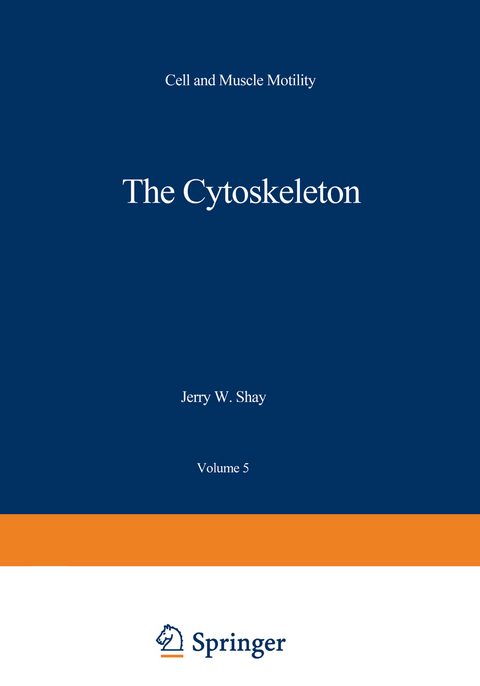
The Cytoskeleton
Seiten
2013
|
Softcover reprint of the original 1st ed. 1984
Springer-Verlag New York Inc.
978-1-4684-4594-7 (ISBN)
Springer-Verlag New York Inc.
978-1-4684-4594-7 (ISBN)
The preceding volumes of Cell and Muscle Motility have focused on various aspects of motile systems in both muscle and non muscle cells. These essays have been critical reviews on topics of current interest and, hopefully, have provided a base from which future investigations may develop. During the past decade, however, much attention in the fields of biochemistry and cell biology has focused on motile systems in non muscle cells. Our current under- standing of the three-dimensional organization of the cytoplasm involve three major fibrous proteins which are collectively known as the cytoskeletal system. These polymorphic cytoskeletal proteins are microtubules (25-nm diameter), microfilaments (6-nm diameter), and intermediate filaments (lO-nm diame- ter). Microtubules consist of tubulin and several well-characterized micro- tubule associated proteins (MAPs) including MAP , MAP , tau, and others. l 2 Microfilaments consist of actin and associate with actin-binding proteins in- cluding a-actinin, filamin, myosin, tropomyosin, vinculin, and others.
Inter- mediate filaments (lO-nm filaments) consist of at least five different tissue- specific classes, including desmin or skeletin (muscle), prekeratin (epithelial), vimentin (mesenchymal), neurofilament (nerve), and glial acidic fibrillary protein (astrocytes). These major fibrous proteins apparently interact with each other as well as other cytoplasmic components and appear to be inti- mately associated with such biological processes as cell shape changes, growth, motility, secretion, cell division, and uptake of materials from the exterior of the cell.
Inter- mediate filaments (lO-nm filaments) consist of at least five different tissue- specific classes, including desmin or skeletin (muscle), prekeratin (epithelial), vimentin (mesenchymal), neurofilament (nerve), and glial acidic fibrillary protein (astrocytes). These major fibrous proteins apparently interact with each other as well as other cytoplasmic components and appear to be inti- mately associated with such biological processes as cell shape changes, growth, motility, secretion, cell division, and uptake of materials from the exterior of the cell.
1 Mechanisms of Intracellular Organelle Transport.- 2 Organization and Function of Stress Fibers in Cells in Vitro and in Situ: A Review.- 3 The Form and Function of Actin: A Product of Its Unique Design.- 4 Changes in Actin during Cell Differentiation.- 5 The Dynamics of Cytoskeletal Organization in Areas of Cell Contact.- 6 Cell Shape and Membrane Receptor Dynamics: Modulation by the Cytoskeleton.- 7 The Biochemistry of Microtubules: A Review.- 8 MAP2 (Microtubule Associated Protein 2).- 9 Genetic Dissection of the Assembly of Microtubules and Their Role in Mitosis.- 10 Cytoskeleton in Platelet Function.- 11 Monoclonal Antibodies to Intermediate Filament Proteins: Use in Diagnostic Surgical Pathology.- Addendum to Chapter 1.
| Zusatzinfo | 258 Illustrations, black and white; XV, 417 p. 258 illus. |
|---|---|
| Verlagsort | New York, NY |
| Sprache | englisch |
| Maße | 170 x 244 mm |
| Themenwelt | Studium ► 1. Studienabschnitt (Vorklinik) ► Anatomie / Neuroanatomie |
| Naturwissenschaften ► Biologie ► Biochemie | |
| ISBN-10 | 1-4684-4594-4 / 1468445944 |
| ISBN-13 | 978-1-4684-4594-7 / 9781468445947 |
| Zustand | Neuware |
| Haben Sie eine Frage zum Produkt? |
Mehr entdecken
aus dem Bereich
aus dem Bereich
Buch | Hardcover (2022)
Urban & Fischer in Elsevier (Verlag)
220,00 €
Struktur und Funktion
Buch | Softcover (2021)
Urban & Fischer in Elsevier (Verlag)
44,00 €
+ Web + Lehrbuch
Buch | Hardcover (2022)
Urban & Fischer in Elsevier (Verlag)
249,00 €


